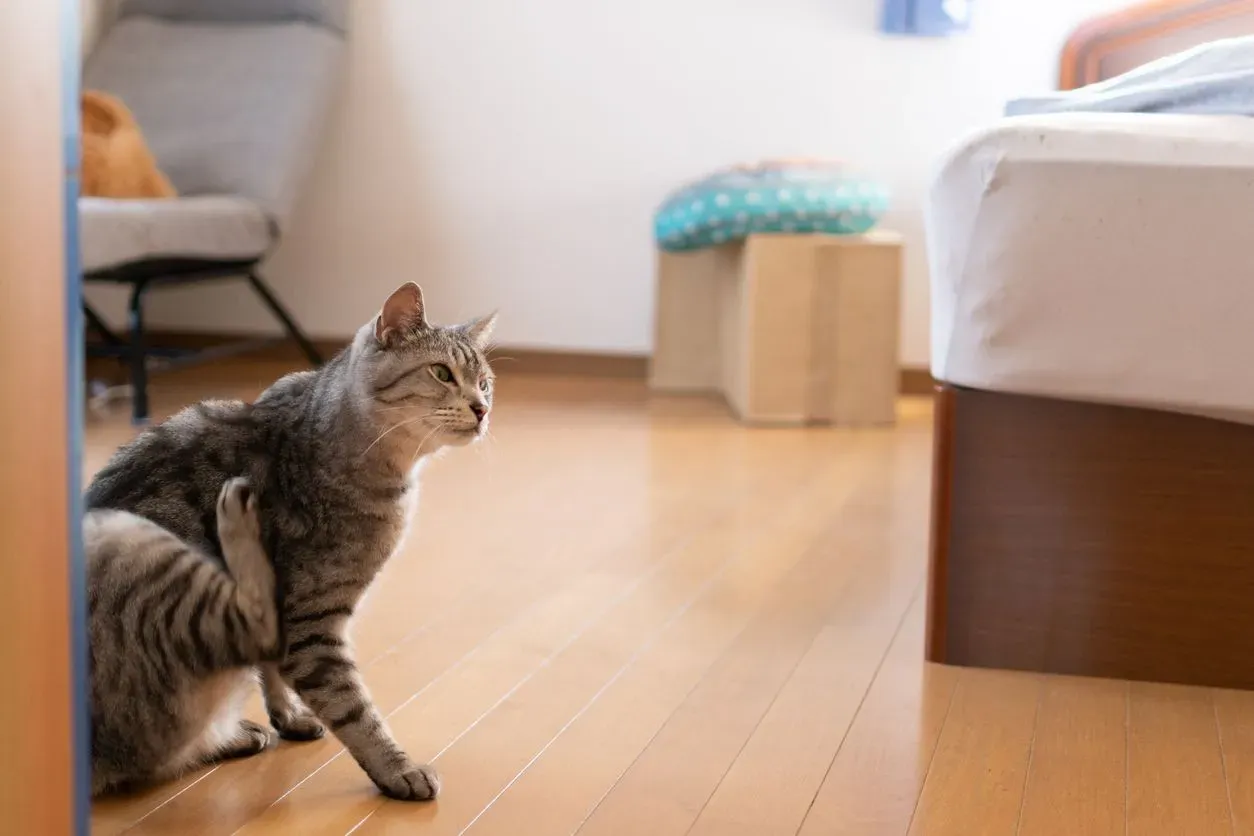Disclaimer: This article does not constitute veterinary advice and is not a substitute for professional veterinary care.
Cat dandruff is a common yet often overlooked issue among cat owners. Those white flakes in your cat’s fur might seem minor, but they frequently signal an underlying health problem like allergies, parasites, or poor grooming. If you’ve noticed your feline friend scratching more or sporting a dull coat, understanding cat dandruff is crucial. In this guide, we’ll cover how to spot it, potential causes, effective treatments, and prevention strategies to keep your cat’s skin healthy.
 A cat sitting on the floor itching its side, showing signs of dry skin and dandruff
A cat sitting on the floor itching its side, showing signs of dry skin and dandruff
What Is Cat Dandruff and How to Identify It?
Cat dandruff, also known as feline dandruff, appears as small white flakes on the skin and throughout the fur. Unlike human dandruff, which is often just a cosmetic nuisance, cat dandruff is rarely standalone—it’s typically a symptom of dry skin, oily skin, or more serious conditions. Flakes can be loose or cling to the fur, and they may concentrate along the back, tail, or base of the tail.
To confirm dandruff in cats, gently part the fur and look for powdery white particles that shake off easily. Accompanying signs include excessive itching, redness, bald patches, or a greasy coat. According to veterinary experts, even mild flaking warrants a check-up, as early detection prevents complications like secondary infections. Cats with long or short hair can both be affected, but overweight or senior cats may struggle more due to limited grooming ability.
Common Causes of Cat Dandruff
Cat dandruff stems from various triggers, from environmental factors to medical issues. Diagnosing the root cause often requires a vet’s expertise, including skin scrapes, blood tests, or allergy trials. Here’s a breakdown of the most frequent culprits:
Allergies: Food, Environmental, or Flea-Related
Allergies top the list for dandruff in cats. Flea saliva can trigger flea allergy dermatitis, causing intense itching and flakes. Food allergies to proteins like beef or fish, or environmental irritants like pollen, lead to chronic skin reactions. These flare seasonally or year-round, demanding long-term management rather than cures.
Parasites and Infections
Mites, lice, ringworm (a fungal infection), or bacterial overgrowth irritate the skin, producing flakes and inflammation. External parasites thrive in warm environments, while internal issues like hyperthyroidism or diabetes exacerbate dryness.
Grooming Challenges and Lifestyle Factors
Senior cats, obese felines, or those with arthritis can’t groom effectively, leading to oil buildup and dead skin accumulation. Dry air from heaters or low-humidity climates worsens this, especially in winter. Poor diet lacking omega-3s or essential fatty acids also contributes to flaky skin.
 Graphic quote from veterinarian Dr. Jo Myers: “Most of the time when a cat has dandruff, it’s due to an underlying condition and the dandruff goes away once that’s successfully treated.”
Graphic quote from veterinarian Dr. Jo Myers: “Most of the time when a cat has dandruff, it’s due to an underlying condition and the dandruff goes away once that’s successfully treated.”
As Dr. Jo Myers, a practicing veterinarian, notes, skin conditions mimic each other, so professional diagnostics are key. Routine wellness exams catch these early.
How to Treat Dry Skin and Dandruff in Cats
Treating cat dandruff focuses on addressing the cause, not just symptoms. Never use human shampoos or over-the-counter remedies without vet approval—they can be toxic. Here’s a vet-guided approach:
Implement Flea and Parasite Prevention
Year-round broad-spectrum preventatives (topical or oral) eliminate fleas, ticks, and mites. This curbs flea allergy dermatitis and related itching.
Grooming and Hygiene Routine
Daily brushing distributes natural oils, removes flakes, and prevents matting. Use a soft curry comb or slicker brush suited to your cat’s coat. For baths, opt for vet-recommended medicated shampoos—rinse thoroughly with lukewarm water. Professional groomers help with hard-to-reach areas.
Dietary Adjustments and Supplements
A balanced, AAFCO-approved diet supports skin health. Vets may prescribe hypoallergenic food trials or omega-3 supplements like fish oil for inflammation. Weight management through portion control aids mobility and grooming.
Environmental Tweaks and Medical Interventions
Add a humidifier to combat dry air. For infections, antibiotics, antifungals, or allergy meds provide relief. Chronic cases might need ongoing therapy.
Water intake matters too—dehydration from kidney issues can dry skin, but force-feeding wet food isn’t the fix; investigate underlying problems.
Preventing Cat Dandruff: Proactive Steps for Healthy Skin
Prevention beats cure for cat dandruff. Maintain these habits:
- Schedule bi-annual vet check-ups for early detection.
- Use monthly flea/tick preventatives religiously.
- Feed high-quality, nutrient-rich cat food.
- Brush 3-5 times weekly, more for longhairs.
- Monitor weight and mobility; encourage play.
- Humidify dry homes and avoid extreme temperatures.
These steps, backed by organizations like the American Animal Hospital Association (AAHA), promote glossy coats and flake-free fur.
When to See a Vet for Cat Dandruff
If flakes persist despite grooming, or if you spot lesions, hair loss, lethargy, vomiting, or diarrhea, seek vet care immediately. Prompt action prevents escalation. Online or in-clinic consults offer tailored plans, including diagnostics.
FAQ: Cat Dandruff and Flaky Skin
What home remedies help cat dandruff?
Gentle brushing and humidifiers aid mild cases, but vet-directed treatments are essential for underlying issues.
Is bathing good for cats with dandruff?
Only with vet-approved shampoos; improper bathing can worsen irritation.
Does diet affect cat dandruff?
Yes—nutrient deficiencies cause flakes, but changes need professional guidance.
Can wet food cure dry skin in cats?
It boosts hydration but won’t fix root causes like allergies or parasites.
In summary, cat dandruff signals the need for action, from better grooming to vet diagnostics. Prioritize your cat’s skin health with routine care and expert advice for a happier, itch-free companion. Consult your veterinarian today for personalized tips, and explore more guides on feline wellness!
References:
- American Veterinary Medical Association (AVMA) guidelines on feline dermatology.
- Studies from the Journal of Feline Medicine and Surgery on allergies and skin health.
